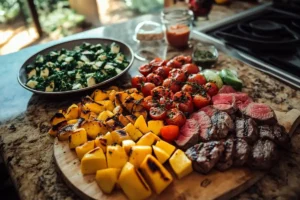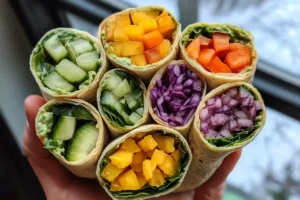In the quest for healthy eating and nutritional balance, Veggie Wrap Calories have emerged as a popular go-to meal option for individuals seeking a blend of taste and health consciousness. With the rising interest in plant-based diets and low-calorie meals, it’s no surprise that veggie wraps are often perceived as a lighter, more nutritious alternative to traditional sandwiches and fast food.
However, the assumption that all veggie wraps are inherently low in calories can sometimes lead to unintended overconsumption. Understanding the calorie content of veggie wraps is crucial, especially for those aiming to manage their weight, track macronutrients, or simply make more informed dietary choices.
In this comprehensive guide, we will delve into the caloric composition of veggie wraps, explore the factors influencing their calorie count, and provide practical insights into crafting healthier, lower-calorie versions.
What is a Veggie Wrap?
A veggie wrap is essentially a tortilla or flatbread filled with an assortment of fresh vegetables, spreads, and sometimes protein alternatives like hummus, tofu, or beans. Unlike sandwiches that rely heavily on bread, veggie wraps often emphasize lighter, more fibrous ingredients, making them an attractive option for those looking to consume more vegetables without sacrificing flavor.
Common fillings for veggie wraps include:
- Leafy greens (spinach, arugula, kale)
- Bell peppers, cucumbers, and tomatoes
- Avocado or guacamole
- Carrots, sprouts, and red onions
- Spreads and dressings (hummus, tzatziki, vinaigrettes)
The versatility of veggie wraps allows for an array of flavor profiles and textures, making them suitable for diverse palates and dietary preferences.
Why Count Calories in Veggie Wraps?

Though veggie wraps are typically associated with health benefits, their calorie content can vary significantly based on the ingredients used. For individuals who are mindful of their caloric intake, whether for weight management, athletic performance, or overall wellness, keeping track of wrap calories is an essential practice.
Moreover, while the bulk of a veggie wrap’s calories often come from the tortilla and sauces rather than the vegetables, certain add-ons like cheese, creamy dressings, or fried components can dramatically elevate the calorie count.
Counting calories in veggie wraps can help:
- Ensure balanced portion sizes
- Prevent hidden calorie overload
- Aid in meal planning and weight control
- Support dietary goals, such as low-carb or high-protein diets
Average Calorie Count of Veggie Wraps
The calorie count of a veggie wrap typically ranges from 250 to 500 calories, depending on the specific ingredients used. A basic veggie wrap made with a whole wheat tortilla, fresh vegetables, and light dressing generally contains around 300 calories. Conversely, wraps featuring heavier sauces, cheese, and fried vegetables can exceed 450 calories or more.
Common Ingredients in Veggie Wraps
The caloric composition of veggie wraps is highly influenced by the ingredients used. Here’s a quick breakdown:
- Tortilla (Whole Wheat) – 120 to 150 calories
- Flour Tortilla (Large) – 200 to 250 calories
- Avocado (Half) – 120 calories
- Hummus (2 tbsp) – 70 calories
- Mixed Vegetables – 40 to 60 calories
- Creamy Dressing (2 tbsp) – 100 to 150 calories
Calorie Contribution by Each Ingredient
Understanding how each component contributes to the overall calorie count can provide better insight into crafting a nutritious yet calorie-conscious wrap:
- Vegetables – Low-calorie, nutrient-dense, rich in fiber and vitamins.
- Proteins (tofu, beans) – Add satiety and texture but can modestly increase calorie counts.
- Dressings and sauces are often the hidden culprits in calorie spikes.
Low-Calorie vs. High-Calorie Veggie Wraps

The distinction between low-calorie and high-calorie veggie wraps often lies in the choice of ingredients and portion sizes.
- Low-Calorie Wraps – Feature lighter tortillas (spinach, corn, or lettuce wraps), minimal dressing, and an abundance of raw vegetables.
- High-Calorie Wraps – Include flour tortillas, generous amounts of avocado or cheese, and creamy sauces like ranch or mayonnaise.
For instance, substituting a whole wheat tortilla for a large flour tortilla can save up to 100 calories, while swapping regular dressing for a light vinaigrette can reduce the calorie count by nearly half.
Factors Affecting Calorie Count
Several factors influence the caloric density of veggie wraps. These include:
- Portion Size – Larger tortillas and excessive fillings naturally lead to higher calorie content.
- Ingredient Choices – Creamy dressings, cheese, and high-fat spreads can significantly increase calories.
- Cooking Methods – Grilled vegetables add minimal calories, while fried or sautéed options can contribute additional fat and energy.
Tortilla Choices and Their Caloric Impact
- Whole Wheat Tortilla – 120 calories (small) to 150 calories (large)
- Corn Tortilla – 60 to 80 calories
- Spinach or Tomato Tortilla – 90 to 110 calories
- Gluten-Free Wraps – Typically higher in calories (130 to 170 calories)
Choosing lettuce wraps or collard greens as an alternative to tortillas can drastically reduce the overall calorie count, bringing the total down by as much as 150 calories per wrap.
Sauces and Dressings – Hidden Calories
While sauces and dressings enhance flavor, they often sabotage calorie goals.
- Creamy Dressings (Caesar, Ranch) – 120 to 150 calories per serving
- Oil-Based Vinaigrettes – 70 to 100 calories
- Hummus or Tzatziki – 50 to 80 calories
Opting for light, oil-free dressings or using herbs and lemon juice can preserve flavor while keeping calorie counts low.
Ingredients and Calorie Breakdown:
- Whole wheat tortilla (medium) – 150 calories
- Mixed greens (1 cup) – 10 calories
- Bell peppers (1/2 cup) – 20 calories
- Cucumber (1/2 cup) – 8 calories
- Carrots (1/4 cup) – 12 calories
- Avocado (1/4 medium) – 60 calories
- Light vinaigrette (1 tbsp) – 35 calories
Total Calories: 295 calories
This option is low in calories yet rich in fiber, vitamins, and healthy fats, making it a perfect lunch or light dinner.
Vegan Veggie Wrap
For those following a plant-based diet, vegan veggie wraps often substitute cheese or yogurt-based dressings with nutrient-dense alternatives like hummus or tahini.
Ingredients and Calorie Breakdown:
- Spinach tortilla (medium) – 120 calories
- Hummus (2 tbsp) – 70 calories
- Kale (1 cup) – 33 calories
- Tomatoes (1/2 cup) – 15 calories
- Red onion (1/4 cup) – 15 calories
- Sprouts (1/4 cup) – 8 calories
Total Calories: 261 calories
High in antioxidants and plant-based proteins, this wrap is both nutritious and filling without excessive caloric intake.
Mediterranean Veggie Wrap
Mediterranean flavors often emphasize fresh herbs, olives, and tzatziki sauce, offering a refreshing yet satisfying meal.
Ingredients and Calorie Breakdown:
- Flour tortilla (large) – 210 calories
- Tzatziki sauce (2 tbsp) – 60 calories
- Spinach (1 cup) – 7 calories
- Cherry tomatoes (1/2 cup) – 15 calories
- Kalamata olives (5 whole) – 25 calories
- Cucumber (1/4 cup) – 4 calories
- Feta cheese (1 tbsp) – 40 calories
Total Calories: 361 calories
This wrap is slightly higher in calories due to the feta cheese and olives but offers heart-healthy fats and Mediterranean nutrients.
Grilled Veggie Wrap
Grilling vegetables can enhance their flavor while maintaining a low-calorie profile.
Ingredients and Calorie Breakdown:
- Whole wheat tortilla (medium) – 150 calories
- Zucchini (grilled, 1/2 cup) – 20 calories
- Portobello mushrooms (grilled, 1/2 cup) – 25 calories
- Eggplant (grilled, 1/4 cup) – 18 calories
- Red bell pepper (grilled, 1/4 cup) – 20 calories
- Olive oil (1 tsp for grilling) – 40 calories
Total Calories: 273 calories
Grilling allows for maximum flavor with minimal added fats, making this wrap a low-calorie powerhouse.
Protein-Packed Veggie Wrap
For individuals seeking higher protein content, adding tofu, beans, or tempeh can transform a simple veggie wrap into a muscle-repairing meal.
Ingredients and Calorie Breakdown:
- Flour tortilla (large) – 200 calories
- Firm tofu (grilled, 3 oz) – 80 calories
- Spinach (1 cup) – 7 calories
- Quinoa (1/4 cup, cooked) – 57 calories
- Roasted red peppers (1/4 cup) – 20 calories
- Tahini dressing (1 tbsp) – 90 calories
Total Calories: 454 calories
This option may be higher in calories but provides sustained energy and protein for satiety.
Store-Bought Veggie Wraps
Not everyone has time to craft wraps at home, which is why store-bought options have grown in popularity. However, pre-packaged veggie wraps often come with hidden calories in the form of sauces and larger tortillas.
Popular Brands and Their Calorie Content:
- Trader Joe’s Veggie Wrap – 390 calories
- Whole Foods Mediterranean Wrap – 420 calories
- Pret A Manger Vegan Wrap – 350 calories
These wraps may be convenient but are often higher in calories than homemade versions.
Fast Food vs. Homemade Veggie Wraps
Fast-food veggie wraps often include larger tortillas, fried vegetables, and heavy dressings.
Comparative Analysis:
- Fast Food Veggie Wrap (average) – 500 to 600 calories
- Homemade Veggie Wrap – 250 to 400 calories
Making wraps at home allows for greater control over portion sizes and ingredient quality, reducing unnecessary calorie consumption.
How to Reduce Calories in Veggie Wraps
Reducing calories in veggie wraps doesn’t mean sacrificing flavor. With a few smart swaps, you can craft wraps that are delicious and low in calories.
Low-Calorie Tortilla Alternatives:
- Lettuce wraps – 5 calories
- Collard greens – 12 calories
- Rice paper wraps – 60 calories
Lean Proteins and Low-Calorie Fillings:
- Chickpeas (1/4 cup) – 70 calories
- Tempeh (3 oz) – 120 calories
- Grilled tofu (3 oz) – 80 calories
These alternatives offer plant-based protein while keeping calorie counts modest.
How to Calculate Calories in Your Own Wrap
Crafting your own veggie wrap at home not only allows for better ingredient control but also ensures greater awareness of caloric intake. This can be particularly beneficial for individuals who are aiming to lose weight, build muscle, or maintain a balanced diet.
Tools and Apps for Accuracy
To ensure precise calorie counting, leveraging technology can make the process far easier. For instance, calorie-tracking apps and online food databases simplify the task by providing detailed nutritional information for virtually any ingredient. Some of the most effective tools include:
- MyFitnessPal – This app boasts an extensive food database, allowing users to log ingredients and generate a total caloric breakdown in just seconds.
- Cronometer – Unlike basic calorie counters, Cronometer tracks micronutrients as well, making it a top choice for those looking to optimize their nutrient intake.
- Lose It! – For individuals who prefer straightforward calorie tracking, this app offers an easy-to-use interface and customizable features.
Moreover, weighing ingredients with a kitchen scale can enhance accuracy by preventing the underestimation of portion sizes. As a result, you are far less likely to exceed your caloric target.
Meal Prepping Veggie Wraps for Weight Loss
When it comes to meal prepping, veggie wraps are an excellent option. Not only do they store well, but they also allow for consistent portion control, ensuring that each meal fits seamlessly into your dietary goals.
Portion Control and Balanced Ingredients
In order to make meal prepping effective and efficient, follow these simple tips:
- Pre-chop vegetables and store them in individual containers to save time during assembly.
- Choose smaller tortillas or lettuce wraps to cut back on excess calories.
- Grill or roast lean proteins like tofu, tempeh, or chickpeas ahead of time.
- Store dressings and sauces separately to keep wraps fresh and crisp.
Example Meal Prep:
- Whole wheat tortilla (medium) – 150 calories
- Grilled bell peppers and zucchini (1 cup combined) – 45 calories
- Spinach (1 cup) – 7 calories
- Hummus (1 tbsp) – 35 calories
Total (per wrap): 237 calories
Consequently, by preparing several wraps at once, you can save both time and effort throughout the week.
High-Protein, Low-Calorie Wrap Ideas
For those who need higher protein intake but still want to maintain a low-calorie diet, incorporating protein-rich, plant-based ingredients into veggie wraps is an excellent strategy. In fact, this simple adjustment can help you stay fuller for longer, reducing the likelihood of unnecessary snacking.
Recipes for Satiety and Energy:
- Tofu and Quinoa Veggie Wrap
- Whole wheat tortilla – 150 calories
- Grilled tofu (3 oz) – 80 calories
- Quinoa (1/4 cup, cooked) – 57 calories
- Spinach and cucumbers (1 cup combined) – 15 calories
- Total: 302 calories
- Chickpea and Avocado Wrap
- Corn tortilla (small) – 80 calories
- Chickpeas (1/4 cup) – 70 calories
- Avocado (1/4 medium) – 60 calories
- Tomatoes and sprouts – 20 calories
- Total: 230 calories
As you can see, protein-packed wraps not only satisfy hunger but also contribute to muscle recovery and overall health.
Best Time to Eat Veggie Wraps
Veggie wraps can be consumed at any time of the day. However, understanding when to eat them can enhance their nutritional benefits and maximize energy levels.
- Lunch – Veggie wraps offer a light yet a filling option that can sustain energy through the afternoon. Additionally, their high fiber content prevents blood sugar spikes.
- Dinner – Opting for smaller wraps or lettuce-based alternatives at dinner helps keep calories low, which is beneficial for those following a weight loss regimen.
- Post-Workout – Including high-protein ingredients such as tofu or chickpeas post-exercise supports muscle repair and growth.
In essence, veggie wraps can easily fit into any meal plan, making them a highly versatile dietary choice.
Nutritional Benefits Beyond Calories
While calorie counting is important, it is equally essential to recognize the wider nutritional advantages that veggie wraps provide. In fact, many wraps are packed with fiber, antioxidants, and essential vitamins that contribute to overall health and well-being.
Key Benefits:
- Vitamins and Minerals – Ingredients like spinach, tomatoes, and cucumbers are rich in vitamin C, potassium, and iron, which are crucial for immune function and circulation.
- Fiber – Veggie wraps often contain fiber-rich ingredients that promote digestive health and satiety.
- Antioxidants – Vegetables such as bell peppers and carrots are packed with antioxidants that help combat oxidative stress and inflammation.
- Healthy Fats – Including avocado or olive oil introduces monounsaturated fats, which support heart health and cholesterol regulation.
Therefore, veggie wraps go beyond being just a low-calorie option; they also deliver comprehensive nutritional value.
Myths About Veggie Wraps and Weight Gain
Although veggie wraps are widely regarded as healthy meal options, certain misconceptions can lead to overconsumption or poor dietary choices.
Common Misconceptions:
- “Veggie wraps are always low in calories” – Despite being loaded with vegetables, large tortillas, cheese, and creamy dressings can significantly increase caloric intake.
- “Bigger wraps provide more nutritional value” – Larger tortillas may contain double the calories without offering additional satiety.
- “Healthy dressings don’t count” – In reality, even olive oil-based dressings can add over 100 calories per serving.
By addressing these myths, you can make smarter decisions and ensure that veggie wraps remain nutrient-dense without being calorie-heavy.
Calorie Chart for Popular Veggie Wrap Recipes
To simplify your choices, here is a quick calorie reference for various veggie wrap recipes:
| Veggie Wrap Type | Calories (Approx.) |
|---|---|
| Classic Veggie Wrap | 295 |
| Vegan Veggie Wrap | 261 |
| Mediterranean Veggie Wrap | 361 |
| Grilled Veggie Wrap | 273 |
| Protein-Packed Veggie Wrap | 454 |
| Store-Bought Veggie Wrap (Average) | 390 – 420 |
| Fast Food Veggie Wrap | 500 – 600 |
Final Thoughts on Veggie Wrap Calories
Ultimately, Veggie Wrap Calories represent a delicious, nutrient-rich alternative to heavier, calorie-laden meals. By paying attention to ingredient choices and portion sizes, you can enjoy flavorful wraps while aligning with your dietary goals.

